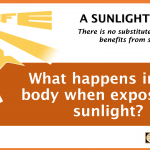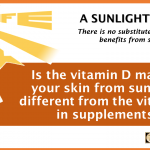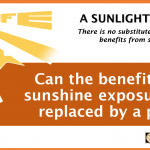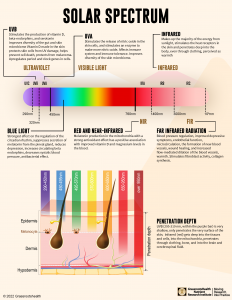Health-Promoting Reactions in the Body Triggered by Exposure to Full-Spectrum Sunlight

From GrassrootsHealth
Wavelengths of Energy from Sunshine: UVB, UVA, Red, Near Infrared, Far Infrared, and Blue Light from sunshine all have unique health consequences
Key Points
- There are several wavelengths of energy from sunshine that trigger specific actions within the body to influence our health; different wavelengths are able to penetrate the skin to different depths and have certain effects on the cells and tissues they reach
- UVB radiation stimulates the production of vitamin D, as well as serotonin and beta-endorphins, UVA promotes the release of nitric oxide into the blood, and both have a positive effect on the diversity of the microbiome on the skin and in the gut
- Blue light has a strong regulatory effect on the circadian rhythm and the release of melatonin from the pineal gland, while red light, near-infrared radiation, and far-infrared radiation have anti-inflammatory and tissue healing effects; infrared radiation also stimulates the production of melatonin inside the mitochondria for a strong antioxidant effect
 The energy given off from the sunshine (aka the solar spectrum) consists of different wavelengths between 300 nm and well over 1 mm. While not all of this radiation is able to penetrate the earth’s atmosphere to reach the earth’s surface, those that do have a wavelength between 100 nm and 1mm, and include ultraviolet radiation (100-400 nm), visible light (400-700 nm), and infrared light (700 nm to over 1 mm).
The energy given off from the sunshine (aka the solar spectrum) consists of different wavelengths between 300 nm and well over 1 mm. While not all of this radiation is able to penetrate the earth’s atmosphere to reach the earth’s surface, those that do have a wavelength between 100 nm and 1mm, and include ultraviolet radiation (100-400 nm), visible light (400-700 nm), and infrared light (700 nm to over 1 mm).
Just as some of this spectrum is able to make it through the atmosphere, different wavelengths are also able to penetrate the skin to different depths of the body’s tissues to have certain effects on the cells within those tissues. This energy from the sun can trigger multiple actions within the body that influence our health, several of which are described in the following video snippets with Dr. Michael Holick, illustrated in the updated graphic, and described in detail below.
 What happens in your body when it is exposed to sunlight?
What happens in your body when it is exposed to sunlight?
Watch this snippet of a video interview with Dr. Michael Holick, as he describes some of the reactions that happen within the body when it is exposed to sunlight.
 How is vitamin D made by the sun different from vitamin D in supplements?
How is vitamin D made by the sun different from vitamin D in supplements?
Watch this snippet of a video interview with Dr. Michael Holick, as he describes some of the differences between vitamin D when made in the skin and vitamin D when taken orally.
 Can the benefits of sunshine exposure be replaced by a pill?
Can the benefits of sunshine exposure be replaced by a pill?
Watch this snippet of a video interview with Dr. Michael Holick, as he describes the multiple benefits of sunshine exposure, and why the health benefits of sunshine cannot be replaced.
What Happens in the Body when it is Exposed to Sunlight?

As shown in this illustration, those at the lower wavelengths (such as UVB) only penetrate the very surface of the skin, while those at higher wavelengths (such as visible light) are able to penetrate deeper. Think of how you are able to see the light from a flashlight on the back of your hand when held against the skin on the palm of the hand – you can visually see the energy traveling through the skin, muscles, blood vessels and tissues of the hand. Infrared radiation can even get into the cells and mitochondria, and can get through clothing and bone!
How Each Wavelength from Sunlight Affects Our Health
Ultraviolet-B Radiation (UVB) – Vitamin D, Serotonin, and Beta-endorphins
UVB (295-319 mn) is at the bottom end of the sunlight spectrum is able to reach the surface of the earth, and therefore our skin, only at specific times and locations. UVB light leads to vitamin D synthesis and can be used as a main source of vitamin D when it is available in plentiful amounts. While UVB is not able to penetrate beyond the very surface of the skin, the vitamin D that is made in the skin circulates throughout the body and tissues, bringing with it a wide range of health benefits.
The vitamin D produced in the skin can also help protect the skin cells from DNA damage, facilitate DNA repair directly upon any UV damage, help prevent cell death, and protect against melanoma. In fact, keratinocytes, which make up over 90% of the outermost layer of skin, cannot rely on vitamin D3 from supplements and must synthesize their own supply of vitamin D directly from sun exposure, or by topical application.
Besides vitamin D, UVB radiation also promotes the production of serotonin and beta-endorphins, chemicals that help with mood enhancement and relaxation, relieve pain, and boost immunity. Serotonin is a neurotransmitter involved not only in mood, but also in cognition, regulation of feeding behavior, anxiety, aggression, pain, sexual activity, and sleep. Recent research has identified an “endogenous opioid-mediated addiction-like pathway,” or a built-in feedback loop between vitamin D levels and sun seeking behavior, triggered by the UV-induced release of beta-endorphins. The suggested benefit is to provide a “reward” for UV-induced vitamin D synthesis when vitamin D levels are low, during which time a greater amount of beta-endorphins are released upon exposure to UVB. As vitamin D levels rise, the sun-seeking behavior and resulting opioid response become repressed as less vitamin D is needed.
Ultraviolet-A Radiation (UVA) – Nitric Oxide
UVA (320-399 nm) exists at a wavelength between UVB and visible light, and is able to reach the deeper levels of the skin but not much further. UVA leads to the release of nitric oxide into the bloodstream which in turn benefits the cardiovascular and metabolic systems, and may offer other immunological benefits beyond those offered by nitric oxide.
Nitric oxide is beneficial for heart health by acting to increase blood flow and lower blood pressure. Additionally, nitric oxide plays a key role in immunity, cellular function, neurotransmission, and it has antimicrobial and anticancer effects.
Ultraviolet Radiation (UVA and UVB) – Balancing the Microbiome of the Skin & Gut
Your gastrointestinal tract and the surface of the skin are home to trillions of microbes (bacteria, viruses, and yeast), called your “microbiome,” which act as their own organ and are crucial to your overall health. Skin health in particular is maintained by a balanced, diverse microbiome, which is in turn affected by nutrition, pH level, hygiene, exposure to toxins, barrier strength, stress levels, sunlight exposure, and overall health. Interestingly, the microbiome of both the skin and the gut contributes to skin health.
UV exposure (and vitamin D itself) can have a healthy, regulatory effect on the microbiome of the skin and the gut, with UVB light having a beneficial impact on the diversity and abundance of the bacteria species of the gut microbiome, and UVB as well as UVA benefitting the skin microbiome. Studies have even shown that several molecules that help protect our skin from UV damage can be produced by the microbiome on our skin upon UV exposure, acting as a sort of natural sunscreen.
While there are several negative effects of chronic, prolonged UV radiation (the kind that that leads to acute sunburn), the positive effects of UV radiation range from maintaining the diversity of the microbiome, to the stimulation of both anti-inflammatory and immunosuppressive pathways that play a helpful role in many diseases, of the skin as well as systemic diseases.
Blue Light – Regulation of Circadian Rhythm, and Melatonin
Blue light (460 nm) is another form of energy from sunlight that has potential health benefits. Studies have shown that blue light has the strongest effect on the suppression of melatonin secretion from the pineal gland upon exposure to the eyes, which likely contributes to the regulation of the circadian rhythm (also known as your internal clock). Daytime sunlight exposure helps guide your circadian rhythm by increasing melatonin levels at night which promotes sleep and allows your body enough time to rejuvenate. A healthy, regular circadian rhythm also promotes healthy mood and improved cognition. Disruptions to circadian rhythm have been shown to increase the risk of cancer, heart disease, and metabolic conditions.
Research has found that, compared to white light therapy, blue light is more effective for resetting circadian rhythms, suppressing nighttime melatonin, and enhancing performance. Blue light may also play a role in the improvement of mood and depression, both seasonal and non-seasonal. Other physiological actions of blue light suggested by studies include an increase in circulating beta endorphins, decreased systolic blood pressure due to nitric oxide mechanisms in the skin, an anti-bacterial effect, and a potential biomodulating effect within the cells.
Beneficial Effects of Red Light and Near-Infrared Radiation
Photobiomodulation is a term used to describe the physiological effects from irradiation by red or near-infrared wavelengths. Red and near-infrared wavelengths have the ability to penetrate inside of our body’s tissues and cells, and can even penetrate through thin clothing. Studies have shown such benefits include improved tissue function, wound healing, anti-inflammatory effects, and improved energy metabolism from red and near-infrared wavelengths. Red light specifically (650-950 nm) may even have a positive association with improved vitamin D and magnesium levels in the blood.
Near infrared (over 950 nm) may penetrate as deep as 8 cm and can penetrate bone, enter the cerebrospinal fluid and the brain. The majority of energy from the sunshine is from infrared radiation; we cannot see it, but it is perceived as warmth as it stimulates the heat receptors in skin.
Conditions that may benefit from photobiomodulation include allergies, hypothyroidism, depression, dementia, cancer, diabetes related symptoms, exercise performance and recovery, pain, and cardiovascular diseases. One of the proposed mechanisms is with the involvement of the mitochondria, since changes in ATP levels have been an observed outcome of red and near-infrared radiation.
Near-Infrared Radiation – Intra-cellular Melatonin Production
New research by Zimmerman, S. and Reiter R. suggests that melatonin (a master antioxidant) exists in two main forms within the body – circulatory melatonin, which is suppressed during the day upon exposure to blue light and has its major effect on sleep and the circadian rhythm, and subcellular melatonin, which is produced and used locally by the mitochondria within our cells. Near-infrared radiation stimulates melatonin production in the mitochondria, which helps protect the skin cells from UV damage, increases collagen production, improves energy metabolism and tissue function, and has wound healing and anti-inflammatory effects.
Far-Infrared Radiation Effects
Far infrared radiation (FIR) is at the far end of the solar spectrum of energy that reaches the earth’s surface, opposite of UVB, with the longest wavelength. Studies suggest that the cardiovascular system especially may benefit from FIR. Reported effects of FIR include blood pressure regulation, improved depressive symptoms, endothelial function, microcirculation, the formation of new blood vessels, wound healing, and increased flow-mediated dilation of the blood vessels, although some of these effects may be attributed solely to the thermal effects of FIR.
Are You Getting Enough Vitamin D from Sunshine?
 Having and maintaining healthy vitamin D levels and other nutrient levels can help improve your health now and for your future. Choose which additional nutrients to measure, such as your omega-3s and essential minerals including magnesium and zinc, by creating your custom home test kit today. Take steps to improve the status of each of these measurements to benefit your overall health. With measurement you can then determine how much is needed and steps to achieve your goals. You can also track your own intakes, symptoms and results to see what works best for YOU.
Having and maintaining healthy vitamin D levels and other nutrient levels can help improve your health now and for your future. Choose which additional nutrients to measure, such as your omega-3s and essential minerals including magnesium and zinc, by creating your custom home test kit today. Take steps to improve the status of each of these measurements to benefit your overall health. With measurement you can then determine how much is needed and steps to achieve your goals. You can also track your own intakes, symptoms and results to see what works best for YOU.
SmartTan.com news articles regularly report medical and scientific information to keep you abreast of current events related to UV light. This information is not intended to be used by any party to make unwarranted health claims to promote sunbed usage. Indoor tanning businesses are obligated to communicate a fair and balanced message to all clients about your products and services including the potential risks associated with indoor tanning. Contact your Smart Tan representative to find out more about what you can and can’t say in your tanning salon business.
© 2023 International Smart Tan Network. All rights reserved.
